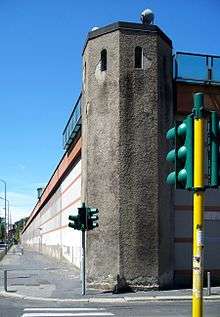San Vittore Prison
Coordinates: 45°27′43″N 9°09′56″E / 45.461937°N 9.165688°E

San Vittore is a prison in the city center of Milan, Italy. Its construction started in 1872 and opened on 7 July 1879.
History
The construction of the new prison was decided after the Italian unification, together with other infrastructure improvement works in Milan in the period between the unification and the city's first town plan of 1889. Until then, prisoners were detained in several other structures not designed as prisons, among them the former Sant'Antonio Abate convent, in the Courthouse and in the former San Vittore convent.
For the construction of the new structure the government acquired terrains in the outskirts of the city, in a sparsely developed area at that time. The building, designed by the engineer Francesco Lucca, takes inspiration from the 18th century Panopticon, with 6 wings with three floors each. The perimeter walls were originally built in medieval style, but they have almost all been rebuilt with modern standards for security reasons.
German occupation
During the German occupation in World War II (1943 – 1945) the prison was partly subject to German jurisdiction, with the SS in control of one of the wings.
Notable inmates
- Mike Bongiorno, television host. Detained for 7 months in 1943 before being transferred to Mauthausen concentration camp.
- Indro Montanelli, journalist and historian, shared prison cell with Bongiorno.
- Gaetano Bresci, anarchist, detained from 29 July to 5 November 1900.
- Renato Vallanzasca, Italian criminal.
- Salvatore Riina, Italian criminal, former chief of the Sicilian Mafia.
- Fabrizio Corona, television personality.
References
Bibliography
- Chiara Bricarelli (a cura di), Una gioventù offesa. Ebrei genovesi ricordano
- Luigi Borgomaneri, Hitler a Milano: crimini di Theodor Saevecke capo della Gestapo, Roma, Datanews, 1997.
- E. Grottanelli, L'amministrazione comunale di Milano e la costruzione del carcere di San Vittore, in "Storia in Lombardia" quadrimestrale dell'Istituto lombardo per la storia del movimento di liberazione in Italia, Milano, Franco Angeli Editore, anno IV, n. 2, 1985.
- Antonio Quatela, "Sei petali di sbarre e cemento", Mursia Editore, Milano, 2013.